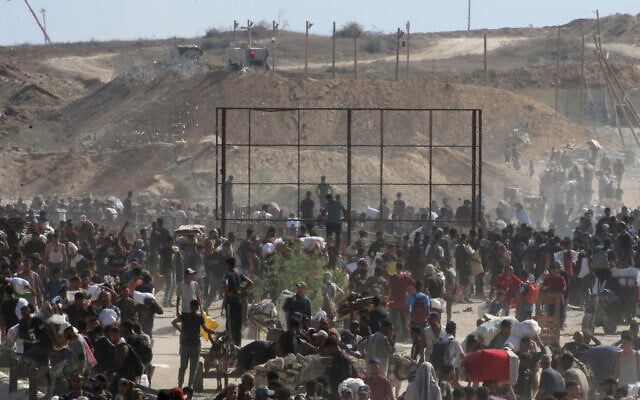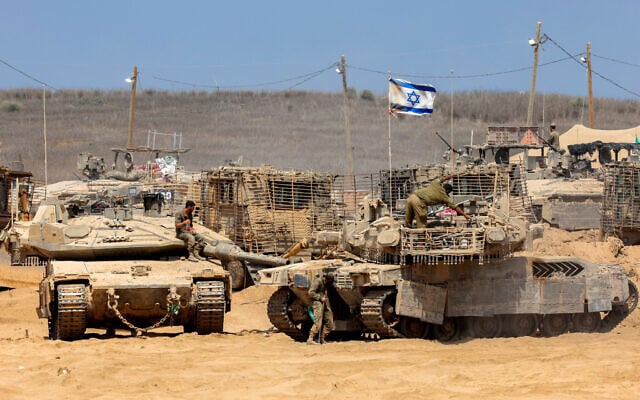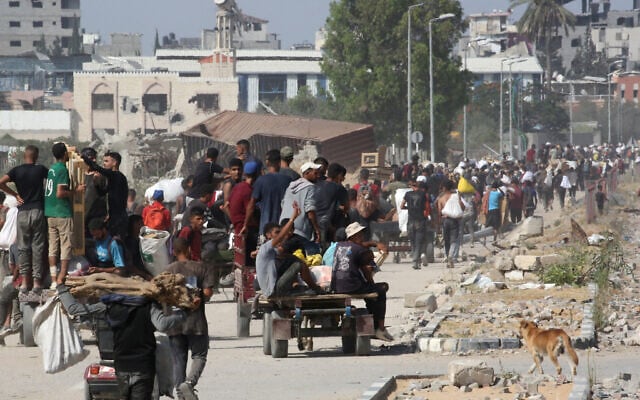 |
| Displaced Palestinians gather to receive aid from a GHF aid distribution point in the so-called ‘Netzarim corridor’ area in the central Gaza Strip on July 30, 2025. (Eyad Baba/AFP) |
Sources in Israeli media reported that Netanyahu met with a select group of ministers this week, reiterating that Hamas would be offered one final opportunity to agree to the ceasefire. Should they reject the terms, Israel is prepared to occupy strategic areas of the Gaza Strip, particularly along its perimeter. This development has intensified fears among the population in Gaza, which many describe as a region already devastated by war, starvation, and displacement.
Hamas, for its part, has accused both Israel and the United States of trying to coerce it into an unfavorable agreement “at gunpoint.” In response, President Trump argued that Hamas has repeatedly sabotaged peace efforts and suggested that the group is deliberately prolonging the conflict. As ceasefire talks stall in Cairo following the withdrawal of Israeli and American negotiating teams from Qatar, frustration is mounting in both Jerusalem and Washington.
A senior Israeli official disclosed to Channel 12 News that Israel submitted a formal document to mediators outlining its non-negotiable positions, including retaining control of the Philadelphia Corridor on the Gaza-Egypt border, denying the reopening of the Rafah Crossing, and rejecting Hamas’s sweeping demands for prisoner releases. These demands, Israeli officials argue, would leave them without leverage to secure the release of the final group of Israeli hostages.
Despite the apparent impasse, the United States is actively working to address the worsening humanitarian crisis in Gaza. Steve Witkoff, the U.S. Special Envoy to the Middle East, arrived in Israel on Wednesday to assess the situation. His visit comes in the wake of global outrage over rising deaths from malnutrition and ongoing violence near aid distribution centers. Witkoff, who had previously postponed a planned visit to Doha for hostage negotiations, is expected to meet with Israeli officials and may even enter Gaza to oversee the operations of the U.S.- and Israeli-backed Gaza Humanitarian Foundation (GHF).
 |
| An Israeli flag flies from a main battle tank deployed at a position along the border with the Gaza Strip and southern Israel on July 29, 2025. (Jack GUEZ / AFP) |
The GHF has been at the center of controversy, with allegations from Hamas that more than 1,000 Palestinians have been killed by Israeli forces near its aid sites. Local reports confirm frequent shootings around these centers as desperate civilians attempt to obtain food, often outside designated safe zones. While Israel accuses Hamas of hoarding aid and manipulating casualty figures, it has acknowledged some civilian deaths in such incidents. The Red Cross, too, has raised concerns, stating that many aid sites are located in or near evacuation zones, making them inaccessible and hazardous.
While ceasefire negotiations appear to have stalled, Israel has initiated daily “humanitarian pauses” in hostilities to allow more aid into Gaza. Nevertheless, aid agencies argue these measures are insufficient. The International Committee of the Red Cross (ICRC) noted that even with increased food deliveries, it could take weeks to stabilize the situation, as existing supplies are dwindling rapidly.
In parallel with military and diplomatic developments, there is growing support among Israeli lawmakers and ministers for the annexation and resettlement of parts of Gaza. On Wednesday, Ze’ev Elkin, a cabinet member from the New Hope party, suggested that the threat of annexation could be used as a pressure tactic against Hamas. He stated that losing land would be the “most painful” outcome for Hamas and urged an ultimatum to force a resolution.
That same day, 22 cabinet ministers and coalition lawmakers signed a letter urging Defense Minister Israel Katz to allow settlement groups to tour northern Gaza to evaluate potential sites for future Jewish settlements. Among the signatories were Communications Minister Shlomo Karhi, National Security Minister Itamar Ben Gvir, and other far-right figures. These groups, including the controversial Nachala Movement, have been actively promoting Jewish resettlement in Gaza, with some activists organizing marches near the Gaza border to mark the 20th anniversary of Israel’s withdrawal from the territory.
The humanitarian toll of the war continues to mount. According to the Hamas-run Health Ministry, over 60,000 people have died in Gaza since the start of the conflict. This figure, however, remains unverified and does not distinguish between civilians and combatants. On the Israeli side, 459 soldiers have died in ground operations in Gaza and related border conflicts. Hamas still holds 50 hostages, 49 of whom were abducted during the October 7, 2023 attack that triggered the war, in which approximately 1,200 people in southern Israel were killed and 251 taken hostage.
In the face of this deteriorating situation, international actors including the United Arab Emirates, Jordan, and Egypt have joined Israel in air-dropping humanitarian aid into Gaza. Israeli officials praised the multinational effort and called on more countries to participate. In a statement posted on social media, the Prime Minister’s Office declared, “We secured the skies, secured the drops, and made sure the food got through. Any country that truly wants to help is welcome to join us.”
As political rhetoric hardens and conditions on the ground worsen, the prospect of a near-term breakthrough remains bleak. Officials in both Israel and the United States have expressed pessimism about the chances of reviving the negotiations, even as intermittent communication between the parties continues. With pressure mounting from all sides, the coming days could mark a pivotal moment for Gaza’s future — and for regional stability as a whole.








